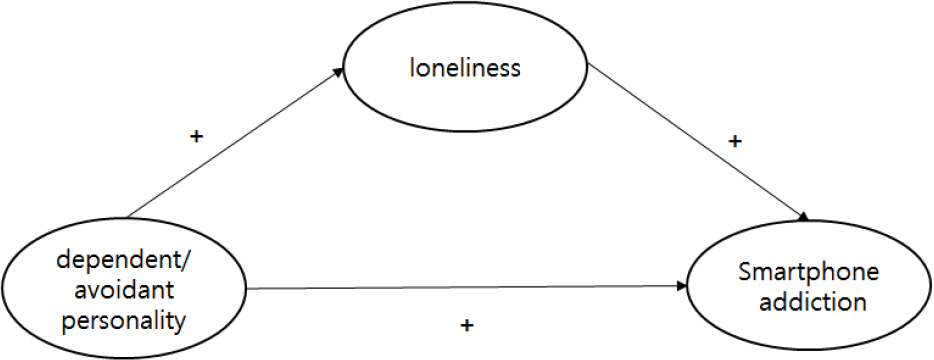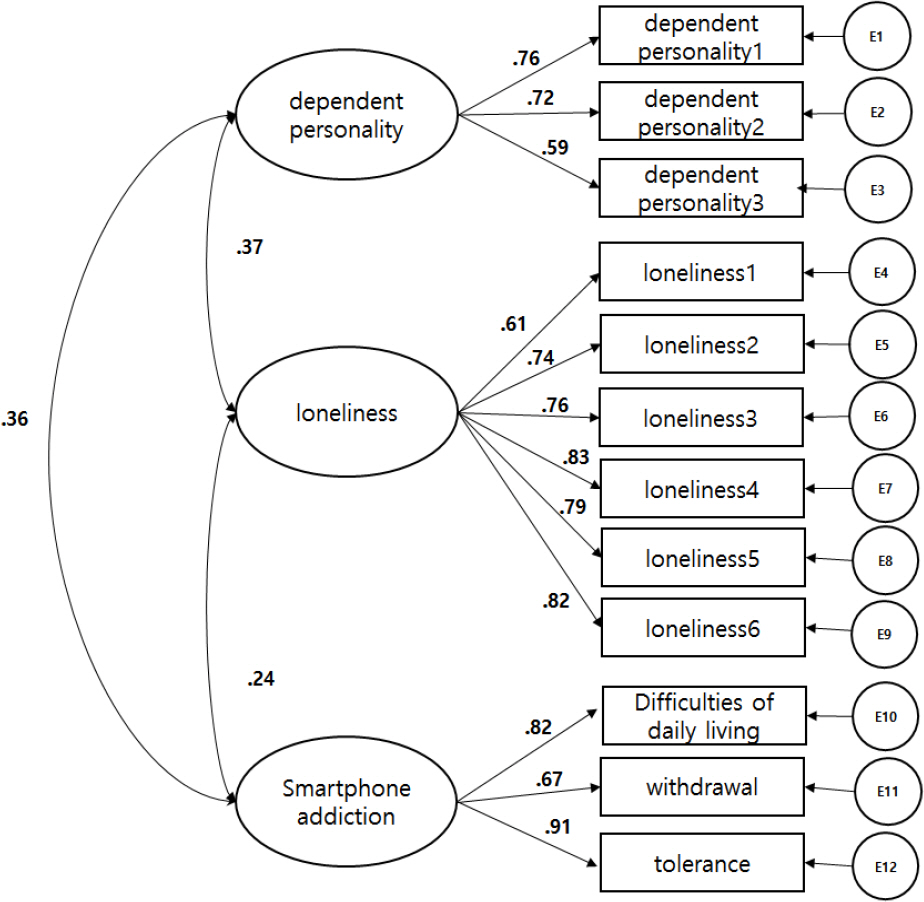Korean J Health Promot.
2016 Dec;16(4):260-267. 10.15384/kjhp.2016.16.4.260.
The Mediating Effects of Loneliness on the Relationship between Smartphone Addiction and Dependent Personality Trait in Adults
- Affiliations
-
- 1Department of Counseling Psychology, Seoul Cyber University, Seoul, Korea. oj256@iscu.ac.kr
- KMID: 2367358
- DOI: http://doi.org/10.15384/kjhp.2016.16.4.260
Abstract
- BACKGROUND
As the number of smartphone users is increasing, smartphone addiction is a recent concern. The purpose of the present study was to examine the mediating effect of loneliness on the relationship between smartphone addiction and dependent/ avoidant personality trait in Adults.
METHODS
A total of 550 adults (male 116, female 434) were selected and rated smartphone addiction scale, dependent and avoidant personality trait scales, and loneliness scale. Pearson correlation coefficients, Structural Equation Model Analysis and Sobel test using SPSS version 21.0 (IBM, New York, NY, USA) and AMOS version 21.0 (IBM, New York, NY, USA) were conducted.
RESULTS
Dependent and avoidant personality significantly were related smartphone addiction and loneliness. Finding in structural equation modeling indicated that the loneliness partially mediated the relationship between dependent personality and smartphone addiction, but did not mediated the relationship between avoidant personality and smartphone addiction.
CONCLUSIONS
This study confirmed partial mediation effect of loneliness on the relationship between smartphone addiction and dependent personality. This finding suggests that future intervention for smartphone addiction should focus on reducing of loneliness and proper coping with loneliness.
Figure
Reference
-
References
1. Chen BX. Always on: how the iPhone unolcked the anything-anytime-anywhere future-and locke us in. Boston: Da Capo Press;2011.2. National Information Society Agency. National information white paper. Seoul: National Information Society Agency;2015.3. National Information Society Agency. The survey on internet overdependence. Seoul: National Information Society Agency;2015.4. Chang MS, Park GP, Jung SH, Woo SW. The relationship among dependent and avoidant personality trait, psychological trait and addiction. The Korean J East West Science. 2011; 14(1):1–19.5. Choi JC. Lee JY. Jang JY. The mediating effects of emotional regulation on the relationship between cellular phone addictive use and personality trait in adolescents. Asian J Education. 2014; 15(2):323–45.6. Choi SW, Kim DJ, Choi JS, Ahn HJ, Choi EJ Song WJ, et al. Comparison of risk and protective factors associated with smartphone addiction and internet addiction. J Behav Addict. 2015; 4(4):308–14.
Article7. Kim DI, Jung YJ. Lee YH. Delphi study on concepts and components of smart media addiction. Asian J Education. 2013; 14(4):49–71.8. Kim HJ, Kim JH, Jung SH. Predictors of smartphone addiction and behavioral patterns. J Cybercommunication Academic Society. 2012; 29(4):55–93.9. Kim Y, Jeong JE, Cho H, Jung DJ, Kwak MJ, Pho MJ, et al. Personality factors predicting smartphone addiction predisposition: behavioral inhibition and activation systems impulsivity, and self-control. PloS One. 2016; 11(8):): e0159788.
Article10. Lee J. An addiction-prone personality: common personality characteristics invarious addictive and compulsive behaviors. Korean J Health Psychology. 2006; 11(3):459–532.11. Frangos CC, Fragkos KC. Psychologic predictors and epidemiology of internet addiction among university students in greece. European Psychiatry. 2011; 26(1):40–54.
Article12. Jeon HS, Jang O. A study on the influence of depression and stress on smartphone addiction among university students: focused on moderating effect of gender. Korean J Youth Studies. 2014; 21(8):103–129.13. Woo RN. Exploration of risk factors and protective factors in addictive mobile phone use [dissertation]. Jinju: Kyungsang University;2009. Korean.14. Kuss DJ, Griffiths MD. Online social networking and addiction–a review of the psychological literature. Int J Environ Res Public Health. 2011; 8(9):3528–52.
Article15. Rokach A. Loneliness updated: an introduction. J Psychol. 2012; 146(1–2):1–6.
Article16. Byun HS, Kweon SY. The effect of elementary school students'loneliness on school life adaptation: the mediating effect of smartphone addiction. J Child Education. 2014; 23(4):303–17.17. Yuh J. The relationship between loneliness and smartphone addiction symptoms among middle school students: testing the mediating role of self-esteem. Korea Youth Research Association. 2016; 23(1):129–52.
Article18. Jang SH, Park YJ. The relations among teenagers'mental health, self-control, and self-esteem according to their mobile phone addiction. J Korean Education Forum. 2009; 8(3):35–41.19. Lim YS, Lee YJ, Han SJ. Research on factors affecting the smartphone addiction of college students based on the GIA. J Korea Academia-Industrial Cooperation Society. 2016; 17(5):56–66.
Article20. Shin HK, Lee MS, Kim HK. An empirical study on mobile usage behavior-focusing on smartphone usage addiction. Infor-matization Policy. 2011; 18(3):50–68.21. Seo JS, Hwang ST. Development and validating of the Korean personality disorders test. Korean J Clin Psychol. 2006; 25(1):273–88.22. Noh EJ, Hwang ST, Ku HM, Lee SH. Reliability and validity of dependent and avoidant subscales of the diagnostic test for personality disorders. Korean J Clinical Psychology. 2008; 27(1):311–32.23. National Information Society Agency. Development of korean smartphone addiction proneness scale for youth and adults. Seoul: National Information Society Agency;2011.24. Russel D, Peplau LA, Cutrona CE. The received UCLA loneliness scale: concurrent and discriminant validity evidence. J Pers Soc Psychol. 1980; 39(3):472–88.25. Kim KH, Kim JH. Korea UCLA Loneliness Scale. J Student Guidance. 1989; 16:13–30.26. Russell DW, Kahn JH, Spoth R, Altmaier EM. Analyzing data from experimental studies: a latent variable structural equation modeling approach. J Couns Psychol. 1998; 45(1):18–29.
Article27. Hong S. The criteria for selecting appropriate fit indices in structural equation modeling and their rationales. Korean J Clin Psychol. 2000; 19(1):161–77.28. An DY, Lee HJ. A preliminary study on the development of group therapy program for managing loneliness. Cognitive Behavior Therapy in Korea. 2011; 11(1):1–15.29. Aljomaa SS, QuDah MFA, Albursan IS, Bakhiet SF, Abduljab-bar AS. Smartphone addiction among university students in the light of some variables. Comput Human Behav. 2016; 61:155–64.
Article30. Lee JH, Leem JM, Son HB, Kwak HW, Chang MS. Development and validating of a smartphone addiction scale based on behavioral addiciton criteria. Korean J Counseling and Psychotherapy. 2016; 28(2):425–43.
- Full Text Links
- Actions
-
Cited
- CITED
-
- Close
- Share
- Similar articles
-
- Structural Equation Model of Smartphone Addiction Based on Adult Attachment Theory: Mediating Effects of Loneliness and Depression
- Mediating Effect of Loneliness on Anxiety and Smartphone Overdependence among Korean Adolescents: Based on the 16th Korea Youth Risk Behavior Survey
- The moderated mediating effect of parental smartphone addiction in the relationship between smartphone addiction, sleep duration, and depression among adolescents
- Smartphone Addiction and Depression: The Mediating Effects of Self-esteem and Resilience among Middle School Students
- Impact of Body Dissatisfaction and Personality Characteristics on Smartphone Addiction




